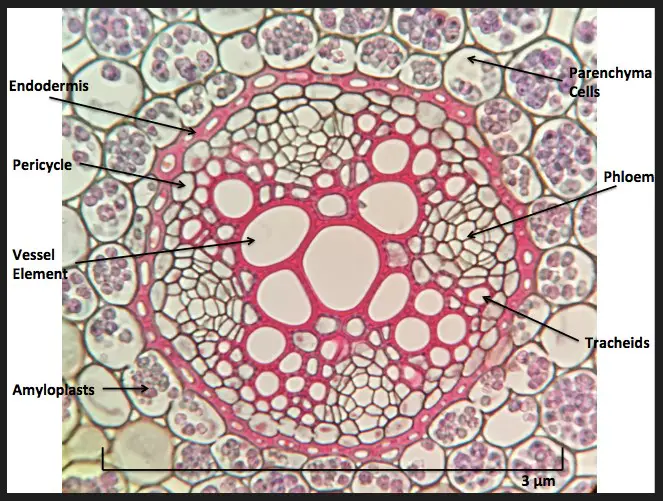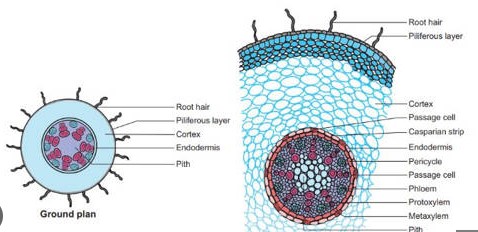Root structures play a pivotal role in the survival and efficiency of plants, serving not only as anchors but also as critical interfaces for water and nutrient uptake. Among these structures, the pericycle and endodermis stand out due to their unique functions and locations within the plant root system. These tissues are essential for understanding how plants manage essential resources and maintain their overall health.
The pericycle, a layer of cells found just inside the endodermis, facilitates the growth of lateral roots and contributes to the regeneration of the root system. In contrast, the endodermis acts as a selective barrier, controlling the flow of water and minerals into the plant’s vascular system. These roles highlight their crucial contributions to plant vitality and development.
While both tissues share proximity within the root, their distinct structures and functions reflect a sophisticated mechanism of plant evolution. The pericycle’s regenerative capabilities complement the protective and selective functions of the endodermis, showcasing a dynamic interplay crucial for plant adaptation and survival.

Pericycle Basics
Definition and Location
The pericycle is a fundamental tissue found in the roots of higher plants, positioned just inside the endodermis and external to the vascular bundles. This tissue layer is pivotal for the root’s ability to branch and regenerate, playing an essential role in the overall architecture and stability of the plant.
Structure Details
The pericycle is composed of one or more layers of non-specialized, parenchymatous cells. These cells retain their ability to divide, a feature that distinguishes the pericycle from surrounding tissues. This regenerative capacity is crucial, as it enables the pericycle to initiate new root branches and contribute to the healing processes if the root is damaged.
Function and Role
The pericycle serves multiple critical functions in plant development and survival:
- Root Branching: It is the origin site for lateral roots, which emerge inward and then break through older tissues to reach the soil, enhancing the plant’s ability to absorb water and nutrients.
- Secondary Growth: In woody plants, the pericycle contributes to the formation of secondary vascular tissues, which are vital for the plant’s growth and stability.
- Stress Response: The pericycle can modify its activity in response to environmental stress, helping the plant adapt to various soil conditions.
Endodermis Overview
Definition and Location
The endodermis is the innermost layer of the cortex in plant roots, forming a tight cylinder around the vascular tissue. This structure acts as a selective barrier, regulating the flow of water and solutes between the root and the shoot in the vascular system.
Structural Characteristics
The endodermis is noted for its unique Casparian strip, a band of suberin and lignin that waterproofs the cell walls, thereby controlling which substances pass into the vascular tissue. This selective permeability is crucial for maintaining the plant’s internal ionic balance and ensuring that only essential nutrients and water are absorbed.
Primary Functions
The primary functions of the endodermis include:
- Selective Absorption: It regulates nutrient and water uptake by controlling which substances pass from the soil into the plant’s vascular system.
- Protection: The endodermis acts as a barrier against soil pathogens and toxins that might otherwise enter the vascular system.
- Homeostasis: By regulating the flow of water and minerals, the endodermis plays a crucial role in maintaining the plant’s internal balance, particularly under varying environmental conditions.
Key Differences
Structural Variations
The pericycle and endodermis differ significantly in their structure and placement within the root. The pericycle is generally a layer of undifferentiated cells capable of growth and regeneration, whereas the endodermis is differentiated, with specialized functions defined largely by the presence of the Casparian strip.
Functional Distinctions
While both the pericycle and endodermis are involved in root function, their roles are distinct:
- The pericycle primarily facilitates growth and development through the initiation of lateral roots and secondary vascular tissues.
- The endodermis focuses on protection and regulation, ensuring that only necessary substances enter the vascular system while excluding harmful elements.
Developmental Roles
In terms of development, the pericycle’s ability to regenerate and form new structures is crucial for the plant’s adaptability and resilience, allowing it to respond to environmental changes and injuries. Conversely, the endodermis develops early in the root’s formation to establish a robust regulatory barrier essential for the plant’s survival from its juvenile stages.

Biological Significance
Role in Plant Growth
The pericycle and endodermis are integral to plant growth, each contributing in unique ways. The pericycle’s ability to initiate lateral root development allows plants to expand their root system, thereby increasing stability and nutrient absorption capabilities. This expansion is critical for supporting above-ground growth, as a larger root system can support a taller and more robust plant structure.
The endodermis, with its selective permeability, ensures that essential nutrients and water are efficiently channeled to the growing parts of the plant. This regulation is crucial during the early growth stages and in mature plants, particularly when resources are scarce or conditions are suboptimal.
Importance in Water Regulation
Water regulation within plants is primarily controlled by the endodermis. This tissue acts as a checkpoint that balances water intake and internal pressure, which is vital for maintaining cell structure and function. Efficient water regulation helps in:
- Stomatal Function: Proper hydration ensures that stomata can regulate gas exchange efficiently.
- Turgor Pressure: Adequate water flow maintains turgor pressure in cells, essential for structural support and nutrient transport.
Influence on Nutrient Uptake
Nutrient uptake is significantly influenced by both the pericycle and the endodermis. The pericycle’s role in forming new roots directly affects how effectively a plant can access soil nutrients. Meanwhile, the endodermis filters the nutrients, ensuring that only those beneficial to the plant are absorbed. This selective uptake is crucial for the plant’s health and productivity, particularly in nutrient-poor soils.
Comparative Analysis
Pericycle in Diverse Plants
Across different plant species, the structure and function of the pericycle can vary significantly, reflecting adaptations to their environments. For example, in aquatic plants, the pericycle helps form aerenchyma, which facilitates oxygen transport to submerged roots, whereas in desert plants, it may enhance the root’s ability to store nutrients and water.
Endodermis across Species
Similarly, the endodermis shows remarkable variation across species. In xerophytes (desert plants), the endodermis is often more developed to prevent water loss, while in hydrophytes (water plants), it is less pronounced due to the abundant water availability.
Adaptations and Evolutionary Aspects
The evolutionary adaptations of the pericycle and endodermis reflect the ecological niches occupied by different plants. These adaptations are seen in the enhanced capacity for water conservation in arid environments or improved flooding tolerance in wetlands, demonstrating the evolutionary importance of these structures in plant survival and success.
Practical Implications
Agricultural Impact
In agriculture, understanding the functions of the pericycle and endodermis can lead to improved crop management and breeding practices. For instance, crops engineered to have a more robust pericycle might exhibit improved drought resistance, while those with a selectively permeable endodermis could show increased efficiency in nutrient uptake, enhancing yield on nutrient-poor soils.
Biotechnological Applications
Biotechnology leverages knowledge of root anatomy to develop crops with desired traits. Genetic modifications that enhance the activity or efficiency of the pericycle or endodermis can lead to plants better suited to specific environments, such as saline soils or urban settings.
Environmental Considerations
The role of the pericycle and endodermis in plant adaptation also has significant environmental implications. As climate change alters soil and weather conditions, plants with adaptable root systems will be better equipped to cope, supporting biodiversity and ecosystem stability.

Frequently Asked Questions
What is the Pericycle?
The pericycle is a layer of cells located between the endodermis and the vascular bundles in plant roots. It plays a key role in initiating secondary root growth and contributes to the plant’s ability to adapt and thrive in various soil conditions.
How Does the Endodermis Function?
The endodermis serves as a critical control point in plants, regulating the uptake of water and minerals from the soil into the vascular system. Its structure, characterized by a Casparian strip, ensures that only select substances pass through, maintaining the plant’s internal balance.
Why are Pericycle and Endodermis Important?
Both the pericycle and endodermis are essential for the health and growth of plants. The pericycle supports structural integrity and new root formation, while the endodermis ensures efficient nutrient and water absorption, critical for the plant’s survival and growth.
Can Pericycle and Endodermis Affect Plant Health?
Yes, the health of the pericycle and endodermis directly impacts overall plant health. Compromised function in these tissues can lead to poor nutrient uptake, reduced growth, and increased susceptibility to environmental stresses.
Conclusion
The pericycle and endodermis represent more than just layers within the plant root; they are vital components that ensure survival, growth, and adaptation. Their complex interplay and distinct functions underscore the sophistication of plant anatomy and its evolution through the ages. As we continue to explore these structures, their study not only enhances our understanding of plant biology but also informs agricultural practices and ecological management.
By appreciating the intricate roles of the pericycle and endodermis, we gain insights into the resilience and adaptability of plants. This knowledge is essential for developing more efficient agricultural strategies and for fostering a deeper appreciation of the plant kingdom’s complexity and its contribution to our ecosystem.

